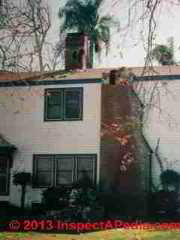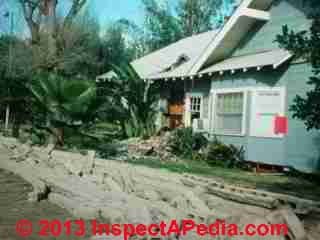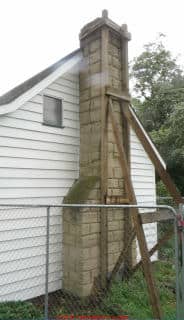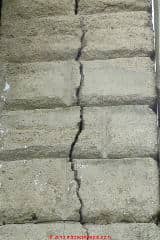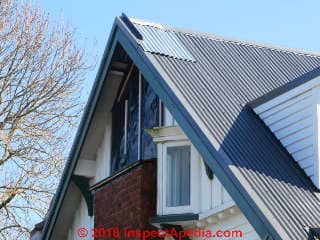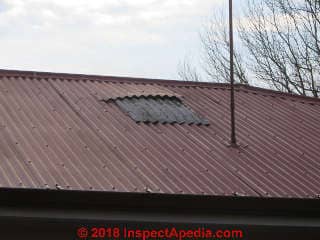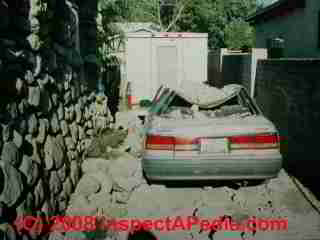 Earthquake Damage & Collapse of Chimneys
Earthquake Damage & Collapse of Chimneys
- POST a QUESTION or COMMENT about earthquake damage to chimneys: causes, evaluation, prevention
Assessment of earthquake damage & damage risk to chimneys:
This article describes chimney inspection procedures and provides examples of potentially fatal chimney collapse hazards in earthquake zones. We include description and photos of chimney collapses during earthquakes.
InspectAPedia tolerates no conflicts of interest. We have no relationship with advertisers, products, or services discussed at this website.
- Daniel Friedman, Publisher/Editor/Author - See WHO ARE WE?
Chimney Collapse Hazards from Earthquake or Storm
In addition to the chimney movement and collapse hazards we discussed above, owners and inspectors in earthquake-prone areas need to consider the safety of their chimney and its ability to resist collapse during a temblor or earthquake.
Un reinforced chimneys often collapse during an earthquake. It's luck which way the collapsing chimney falls. In some cases the chimney falls into the structure, possibly killing the occupants below. In our photo (below left) the chimney happily fell away from the home and into the yard.
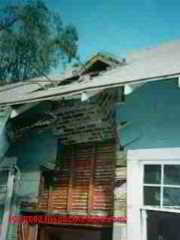 ...
...
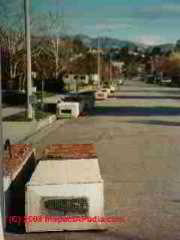
The photo of ten masonry chimneys all lined up in the street (above right) was taken by the author, D Friedman, in Northridge California after the Northridge Meadows earthquake in 1986.
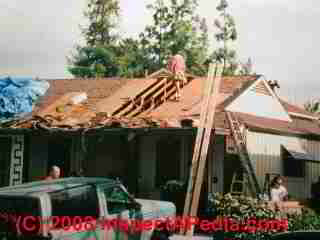 ...
... 
The photos above show additional examples of earthquake damage to masonry chimneys. The chimney fell through the house at above left, luckily into the living room rather than a bedroom where people were sleeping, or it is possible that the occupants would have been crushed.
At above right an un reinforced stone chimney and stone house wall fell onto and crushed the automobile.
Other chimney collapse hazards can be frightening too, such as flues or chimneys collapsing trapping people working on them or simply someone who happened to be on a roof.
At above we see two different extents of chimney damage at the Northridge California 1994 quake.
The chimney projecting through the ridge of the roof collapsed onto the roof while an exterior wall chimney fell into the yard below.
Above:, another home inspected by the author [DF], the entire building was shifted abouit 14" over its foundation. You can see the collapsed chimney in the center of the photograph. A chimney that falls into the home or through its roof is more likely to cause injury to occupants.
Above: chimnney split by earthquake damage near Christchurch, New Zealand.
The most common evidence of earthquake-damaged chimneys on the South Island in New Zealand two years after the 2010-2011 quakes was evidence that chimneys had been partially or completely removed.
Above, a common illustration of earthquake-damaged chimneys is that the chimney has been removed or fallen off of the building and the chimney penetration of the roof has been patched.
More photos of chimney and other damage from the New Zealand earthquakes in 2010 and 2011 are
at EARTHQUAKE DAMAGE PHOTOS Christchurch 2010-2011
See CHIMNEY COLLAPSE RISKS, REPAIRS.
Also see our notes about Loose Wobbly Chimneys that need lateral support. A news report of a person who was trapped inside of a collapsing chimney is in our footnotes
at Rooftop View Turns to Darkness.
...
Reader Comments, Questions & Answers About The Article Above
Below you will find questions and answers previously posted on this page at its page bottom reader comment box.
Reader Q&A - also see RECOMMENDED ARTICLES & FAQs
Comment: chimney damage at Northridge Meadows Earthquake
(Aug 31, 2012) Dave Laverdiere Owner Boston Bri said:
GREAT website guys! The chimneys lying in the street in the above photo look like Rampart General (precast chimneys) and that had to have been the Northridge earthquake of January 17th, 1994. I believe Northridge Meadows was the name of the apartment complex that collapsed killing 16 people that day although I could be wrong. In any case, keep up the great work. Very informative and easy to understand....
...
Continue reading at EARTHQUAKE DAMAGED FOUNDATIONS or select a topic from the closely-related articles below, or see the complete ARTICLE INDEX.
Or see these
Recommended Articles
- ABANDONED CHIMNEYS
- CHIMNEY INSPECTION DIAGNOSIS REPAIR - home
- EARTHQUAKE DAMAGE - home
- EARTHQUAKE DAMAGED CHIMNEYS
- EARTHQUAKE DAMAGED FOUNDATIONS
- EARTHQUAKE DAMAGE JOURNAL
- EARTHQUAKE DAMAGE PHOTOS CA 1994
- EARTHQUAKE DAMAGE PHOTOS CHRISTCHURCH 2010-2011
- EARTHQUAKES, MAN-MADE
- MODULAR METAL ROOF SHINGLE SYSTEM - earthquake warning comments related to metal roof nois
Suggested citation for this web page
EARTHQUAKE DAMAGED CHIMNEYS at InspectApedia.com - online encyclopedia of building & environmental inspection, testing, diagnosis, repair, & problem prevention advice.
Or see this
INDEX to RELATED ARTICLES: ARTICLE INDEX to CHIMNEYS & FLUES
Or use the SEARCH BOX found below to Ask a Question or Search InspectApedia
Or see
INDEX to RELATED ARTICLES: ARTICLE INDEX to BUILDING STRUCTURES
Or use the SEARCH BOX found below to Ask a Question or Search InspectApedia
Ask a Question or Search InspectApedia
Try the search box just below, or if you prefer, post a question or comment in the Comments box below and we will respond promptly.
Search the InspectApedia website
Note: appearance of your Comment below may be delayed: if your comment contains an image, photograph, web link, or text that looks to the software as if it might be a web link, your posting will appear after it has been approved by a moderator. Apologies for the delay.
Only one image can be added per comment but you can post as many comments, and therefore images, as you like.
You will not receive a notification when a response to your question has been posted.
Please bookmark this page to make it easy for you to check back for our response.
IF above you see "Comment Form is loading comments..." then COMMENT BOX - countable.ca / bawkbox.com IS NOT WORKING.
In any case you are welcome to send an email directly to us at InspectApedia.com at editor@inspectApedia.com
We'll reply to you directly. Please help us help you by noting, in your email, the URL of the InspectApedia page where you wanted to comment.
Citations & References
In addition to any citations in the article above, a full list is available on request.
- [1] Arakida, Masaru. "Measuring vulnerability: The ADRC perspective for the theoretical basis and principles of indicator development." Measuring Vulnerability to Natural Hazards–towards disaster resilient societies, United Nations University Press, Tokyo (2006): 290-299.
- [2] Comerio, Mary C. "Public policy for reducing earthquake risks: a US perspective." Building Research & Information 32, no. 5 (2004): 403-413.
- [3] Kamat, Vineet R., and Sherif El-Tawil. "Evaluation of augmented reality for rapid assessment of earthquake-induced building damage." Journal of computing in civil engineering 21, no. 5 (2007): 303-310.
- [4] Kovacs, Paul. Reducing the risk of earthquake damage in Canada: Lessons from Haiti and Chile. Institute for Catastrophic Loss Reduction, 2010.
- [5] Mills, Evan, Evan Mills, and Ivo Knoepfel. Energy-efficiency options for insurance loss prevention. Environmental Energy Technologies Division, Ernest Orlando Lawrence Berkeley National Laboratory, 1997.
- [6] Noji, Eric K., and Keith T. Sivertson. "Injury prevention in natural disasters. A theoretical framework." Disasters 11, no. 4 (1987): 290-296.
- [7] Peek-Asa, Coritme, Jess F. Kraus, Linda B. Bourque, Dushyanthi Vimalachandra, Jenny Yu, and Jackie Abrams. "Fatal and hospitalized injuries resulting from the 1994 Northridge earthquake." International Journal of Epidemiology 27, no. 3 (1998): 459-465.
- [8] John Tagliabue, Parts of Low Country Are Now Quake Country", The New York Times, 27 March 2013, p. A6.
- [9] "A Foundation for Unstable Soils," Harris Hyman, P.E., Journal of Light Construction, May 1995
- [10] "Backfilling Basics," Buck Bartley, Journal of Light Construction, October 1994
- [11] "Inspecting Block Foundations," Donald V. Cohen, P.E., ASHI Reporter, December 1998. This article in turn cites the Fine Homebuilding article noted below.
- [12] Henry Fountain, "Experts Eye Oil and Gas Industry as Quakes Shake Oklahoma", The New York Times, 13 December 2013, p. A20, A23.
- [13] Stein, Ross S. "The role of stress transfer in earthquake occurrence." Nature 402, no. 6762 (1999): 605-609. US Geological Survey, MS 977, Menlo Park, California 94025, USA , Email: rstein@usgs.gov.
- [14] Lin, Jian, and Ross S. Stein. "Stress triggering in thrust and subduction earthquakes and stress interaction between the southern San Andreas and nearby thrust and strike‐slip faults." Journal of Geophysical Research: Solid Earth (1978–2012) 109, no. B2 (2004).
- [15] Parsons, Tom, Ross S. Stein, Robert W. Simpson, and Paul A. Reasenberg. "Stress sensitivity of fault seismicity: A comparison between limited‐offset oblique and major strike‐slip faults." Journal of Geophysical Research: Solid Earth (1978–2012) 104, no. B9 (1999): 20183-20202.
- [16] Toda, Shinji, Jian Lin, Mustapha Meghraoui, and Ross S. Stein. "12 May 2008 M= 7.9 Wenchuan, China, earthquake calculated to increase failure stress and seismicity rate on three major fault systems." Geophysical Research Letters 35, no. 17 (2008).
- [17] Parsons, Tom, and Douglas S. Dreger. "Static‐stress impact of the 1992 Landers earthquake sequence on nucleation and slip at the site of the 1999 M= 7.1 Hector Mine earthquake, southern California." Geophysical research letters 27, no. 13 (2000): 1949-1952.
- [18] King, G. C. P., and M. Cocco. "Fault interaction by elastic stress changes: New clues from earthquake sequences." Advances in Geophysics 44 (2001): 1-VIII.
- [19] Toda, Shinji, and Ross Stein. "Toggling of seismicity by the 1997 Kagoshima earthquake couplet: A demonstration of time-dependent stress transfer." Journal of geophysical research 108, no. B12 (2003): 2567.
- [20] Simpson, Robert W., and Paul A. Reasenberg. "Earthquake-induced static stress changes on central California faults." US Geol. Surv. Prof. Pap 55 (1994): 89.
- [21] Cocco, Massimo, Concetta Nostro, and G. Ekström. "Static stress changes and fault interaction during the 1997 Umbria-Marche earthquake sequence." Journal of seismology 4, no. 4 (2000): 501-516.
- [22] Zeng, Yuehua. "Viscoelastic stress‐triggering of the 1999 Hector Mine Earthquake by the 1992 Landers Earthquake." Geophysical research letters 28, no. 15 (2001): 3007-3010.
- [23] Toda, Shinji, Jian Lin, and Ross S. Stein. "Using the 2011 M= 9.0 Tohoku earthquake to test the Coulomb stress triggering hypothesis and to calculate faults brought closer to failure." Earth Planets Space 63 (2011): 1-6.
- [24] Freed, Andrew M. "Earthquake triggering by static, dynamic, and postseismic stress transfer." Annu. Rev. Earth Planet. Sci. 33 (2005): 335-367. Quoting:
Earthquake triggering is the process by which stress changes associated with an earthquake can induce or retard seismic activity in the surrounding region or trigger other earthquakes at great distances. Calculations of static Coulomb stress changes associated with earthquake slip have proven to be a powerful tool in explaining many seismic observations, including aftershock distributions, earthquake sequences, and the quiescence of broad, normally active regions following large earthquakes. Delayed earthquake triggering, which can range from seconds to decades, can be explained by a variety of time-dependent stress transfer mechanisms, such as viscous relaxation, poroelastic rebound, or afterslip, or by reductions in fault friction, such as predicted by rate and state constitutive relations. Rapid remote triggering of earthquakes at great distances (from several fault lengths to 1000s of km) is best explained by the passage of transient (dynamic) seismic waves, which either immediately induce Coulomb-type failure or initiate a secondary mechanism that induces delayed triggering. The passage of seismic waves may also play a significant role in the triggering of near-field earthquakes. - [25] " Man-made earthquake strikes Christchurch ", The New Zealand Herald, 17 April 2012, Quoting: Man-made earthquake strikes Christchurch 3:58 PM Tuesday Apr 17, 2012 A magnitude 4 earthquake is to strike Christchurch - but this one will be man-made. The "earthquake" struck at 11.30am, at QEII Stadium, at a depth of up to 12km. The jolt is part of tests by the Earthquake commission into whether liquefaction-prone land in the east of the city can be repaired. About 25 small underground explosives are to be placed up to 12 metres deep and set off to simulate an earthquake of about magnitude 4.
- [26] William Ellsworth (ellsworth@usgs.gov), Jessica Robertson (jrobertson@usgs.gov), and Christopher Hook (703-648-4460), "Man-Made Earthquakes Update", USGS, 12 July 2013, retrieved 13 December 2013, original source: http://www.usgs.gov/blogs/features/usgs_top_story/man-made-earthquakes/
- [27] Katie M. Keranen, Heather M. Savage, Geoffrey A. Abers and Elizabeth S. Cochran, "Potentially induced earthquakes in Oklahoma, USA: Links between wastewater injection and the 2011 Mw 5.7 earthquake", Geology, January 2013, retrieved 12/13/2013, original source: http://geology.gsapubs.org/content/early/2013/03/26/G34045.1.abstract
Quoting from the abstract:
Significant earthquakes are increasingly occurring within the continental interior of the United States, including five of moment magnitude (Mw) ≥ 5.0 in 2011 alone. Concurrently, the volume of fluid injected into the subsurface related to the production of unconventional resources continues to rise. Here we identify the largest earthquake potentially related to injection, an Mw 5.7 earthquake in November 2011 in Oklahoma. The earthquake was felt in at least 17 states and caused damage in the epicentral region. It occurred in a sequence, with 2 earthquakes of Mw 5.0 and a prolific sequence of aftershocks. We use the aftershocks to illuminate the faults that ruptured in the sequence, and show that the tip of the initial rupture plane is within ∼200 m of active injection wells and within ∼1 km of the surface; 30% of early aftershocks occur within the sedimentary section. Subsurface data indicate that fluid was injected into effectively sealed compartments, and we interpret that a net fluid volume increase after 18 yr of injection lowered effective stress on reservoir-bounding faults. Significantly, this case indicates that decades-long lags between the commencement of fluid injection and the onset of induced earthquakes are possible, and modifies our common criteria for fluid-induced events. The progressive rupture of three fault planes in this sequence suggests that stress changes from the initial rupture triggered the successive earthquakes, including one larger than the first. - [28] David J. Hayes, "Is the Recent Increase in Felt Earthquakes in the Central US Natural or Manmade?", David J. Hayes, Deputy Secretary, U.S. Department of the Interior, DOI News, retrievedf 12/13/2013, original source: http://www.doi.gov/ news/doinews/Is-the-Recent-Increase-in-Felt-Earthquakes -in-the-Central-US-Natural-or-Manmade.cfm
- NFPA 211 - Standards for Chimneys & Fireplaces, NFPA 211: Standard for Chimneys, Fireplaces, Vents, and Solid Fuel-Burning Appliances, 2006 Edition (older editions and standards are found at the same bookstore)
- NFPA #211-3.1 1988 - Specific to chimneys, fireplaces, vents and solid fuel burning appliances.
- NFPA # 54-7.1 1992 - Specific to venting of equipment with fan-assisted combustion systems.
- GAMA - Gas Appliance Manufacturers' Association has prepared venting tables for Category I draft hood equipped central furnaces as well as fan-assisted combustion system central furnaces.
- National Fuel Gas Code, an American National Standard, 4th ed. 1988 (newer edition is available) Secretariats, American Gas Association (AGA), 1515 Wilson Blvd., Arlington VA22209, and National Fire Protection Association (NFPA), Batterymarch Park, Quincy MA 02269. ANSI Z223.1-1988 - NFPA 54-1988. WARNING: be sure to check clearances and other safety guidelines in the latest edition of these standards.
- Fire Inspector Guidebook, A Correlation of Fire Safety Requirements Contained in the 1987 BOCA National Codes, (newer edition available), Building Officials and Code Administrators International, Inc. (BOCA), Country Club HIlls, IL 60478 312-799-2300 4th ed. Note: this document is reissued every four years. Be sure to obtain the latest edition.
- Uniform Mechanical Code - UMC 1991, Sec 913 (a.) Masonry Chimneys, refers to Chapters 23, 29, and 37 of the Building Code.
- New York 1984 Uniform Fire Prevention and Building Code, Article 10, Heating, Ventilating, and Air Conditioning Requirements
- New York 1979 Uniform Fire Prevention & Building Code, The "requirement" for 8" of solid masonry OR for use of a flue liner was listed in the One and Two Family Dwelling Code for New York, in 1979, in Chapter 9, Chimneys and Fireplaces, New York 1979 Building and Fire Prevention Code:
- "Top Ten Chimney (and related) Problems Encountered by One Chimney Sweep," Hudson Valley ASHI education seminar, 3 January 2000, contributed by Bob Hansen, ASHI
- Chimney Inspection Checklist, Carson Dunlop, Associates, Toronto, Ontario
- "Rooftop View Turns to Darkness," Martine Costello, Josh Kovner, New Haven Register, 12 May 1992 p. 11: Catherine Murphy was sunning on a building roof when a chimney collapsed; she fell into and was trapped inside the chimney until rescued by emergency workers.
- "Chimneys and Vents," Mark J. Reinmiller, P.E., ASHI Technical Journal, Vol. 1 No. 2 July 1991 p. 34-38.
- Our recommended books about building & mechanical systems design, inspection, problem diagnosis, and repair, and about indoor environment and IAQ testing, diagnosis, and cleanup are at the InspectAPedia Bookstore. Also see our Book Reviews - InspectAPedia.
- NFPA 211 - 3-1.10 - Relining guide for chimneys
- NFPA 211 - 3-2 - Construction of Masonry Chimneys
- NFPA 211 - 3-3 - Termination Height for chimneys
- NFPA 211 - 3-4 - Clearance from Combustible Material
- NFPA 54 - 7-1 - Venting of Equipment into chimneys
- In addition to citations & references found in this article, see the research citations given at the end of the related articles found at our suggested
CONTINUE READING or RECOMMENDED ARTICLES.
- Carson, Dunlop & Associates Ltd., 120 Carlton Street Suite 407, Toronto ON M5A 4K2. Tel: (416) 964-9415 1-800-268-7070 Email: info@carsondunlop.com. Alan Carson is a past president of ASHI, the American Society of Home Inspectors.
Thanks to Alan Carson and Bob Dunlop, for permission for InspectAPedia to use text excerpts from The HOME REFERENCE BOOK - the Encyclopedia of Homes and to use illustrations from The ILLUSTRATED HOME .
Carson Dunlop Associates provides extensive home inspection education and report writing material. In gratitude we provide links to tsome Carson Dunlop Associates products and services.


